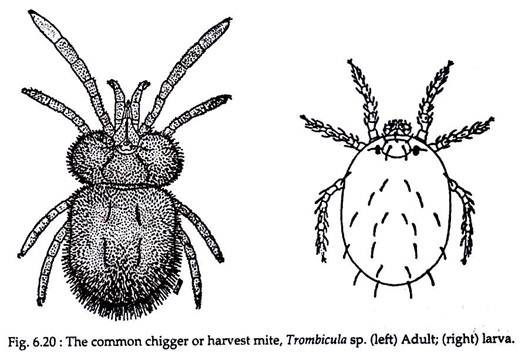The life cycle of all mites include four stages – egg, larva, nymph and adult. However, there are typically a single larval stage and two nymphal stages (the protonymph and deutonymph) in the life cycle. The number of nymphal generation may be less or more in some species.
Biology of important mites and their role as vectors:
Most species of mites are important from the standpoint of veterenary science as they cause transmission of several diseases to domestic as well as other subhuman vertebrates. Some species also transmit human diseases (see Table 6.11) including allergy. I Here mite species, those participates as vector for human diseases will be discussed in brief.
ADVERTISEMENTS:
1. The house mouse mite:
The house mouse mite, Liponyssus sanguineus belongs to the order Musostigmata and family Dermanyssidae. This mite is known to occur in northern Africa, Asia, Europe and US and is the only one that has been definitely incriminated in the transmission of a human disease, Rickettsialpox.
The house mouse, Mus musculus, is the preferred host, but the a mite can feed on rats and other rodents and can readily attack man and transmits the c pathogen, Rickettsia akari.
ADVERTISEMENTS:
Life history:
L. sanguineus has five development stages, the adult male and female, the eggs, the non-feeding larva, the protonymph and the deutonymph. Both nymphal instars take blood meal. Adult females feed several times. Each feeding being followed by oviposition. The total period of time from deposition of the eggs to emergence of the adult is 17 to 23 days.
Unfed females are known to have lived as long as 51 days, and the female that had fed and oviposited twice is recorded as living 9 weeks. Engorged nymph and adults may be found, sometimes in great numbers, in building, in the vicinity of rodent nests and runways.
Rickettsialpox is a mild febrile disease, with no signs except a vesicular rash that follows the onset of the fever by 3 or 4 days. There is an scar or initial lesion caused by the bite of the mites.
ADVERTISEMENTS:
2. Chigger mites:
These mites belonging to the family Trombiculidae, order Prostimata, comprise a group of mites, parasitic to human only at their larval stage. Nymph and adults are free-living, feeding on insect eggs. Important chigger mites include Trombicula akamushi causing scrub typhus to human; Trombicula pelkini, T. goldii, T. wichmanni etc. causing human dermatitis (Fig. 6.20).
Life history:
The bright red adult mites are found on the surface of moist ground or to a depth of 2 or 3 inch in dried soil, root stocks of clumps of grass or under log. With few exceptions, eggs are laid singly in the soil.
Females become ready to lay eggs within a few days after the adult stage has been reached and once egg laying has begun, it continues as long as conditions are satisfactory. After 4 to 6 days of incubation period, the eggs hatch to produce a quiescent stage, the deutovum which remains within the egg shell fragments.
In about a week, after completion of the deutoval stage, the fully formed red hexapod larva emerges and crawls about rapidly in search of a host. The larva can live for a considerable period without feeding. The larval chigger feeds once but requires 1 to 3 or 4 days (up to a month) for engorgement.
The chigger then drops to ground and become a quiscent prenymph or nymphocrysalis. After about a week the active, eight-legged nymph emerges and feeds on insect eggs or soft-bodied invertebrates for about a week.
Then it goes into another inactive stage, the imagocrysalis. This stage lasts for about a week and then mouths into the adult. The minimum time required to complete the life cycle is variable, e.g., 50 days for T. splendens (vector of scrub typhus in India) and 71 days for T. batatas.
ADVERTISEMENTS:
Transmission of scrub typhus:
The larval mite serves as the vector in carrying the pathogen, Rickettsia akari causing scrub typhus. They transmit the pathogen from small mammals like voles, rats to human hosts. Larvae get the pathogen through transovarian transmission from the mother mites. The larvae penetrate the epidermis through the mouth parts and inject salivary secretion containing the microorganisms into the host.
The disease has an incubation period of 6 to 21, usually 10 to 12 days. During the first 5 to 7 days, it is characterised by headache, apathy and general malaise, fever, lymph adenitis and an eschar.
The eschar is the primary lesion which originates at the point of chigger bite. It slowly enlarges to 8 to 12 mm and becomes necrotic in the centre on the fifth to eighth day, red rashes appear on the trunk that may spread to the extremities.
Other symptoms of scrub typhus included enlarged spleen, delirium, nervous disturbances, deafness and even pneumonitis, in extreme cases. The occurrence of this disease is known from Japan, South-East Asia, adjacent islands of Indian Ocean, Australia etc.
3. The tropical rat mite:
The tropical rat mite, Ornithonyssus bacoti, is reported from many parts of the world. It acts as a vector of Q. fever by transmitting the pathogen, Coxiella burnetti. The blood sucking protonymph is the infective stage of the disease.

